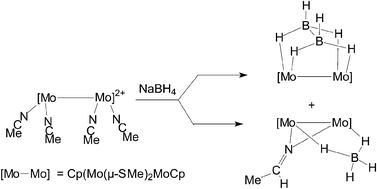Reaction of BH4− with {Mo2Cp2(μ-SMe)n} species to give tetrahydroborato, hydrido or dimetallaborane compounds: control of product by ancillary ligands
Abstract
The reaction of mono- or dichloro-dimolybdenum(III) complexes [Mo2Cp2(μ-SMe)2(μ-Cl)(μ-Y)] (Cp = η5-C5H5; 1, Y = SMe; 2, Y = PPh2; 3, Y = Cl) with NaBH4 at room temperature gave in high yields tetrahydroborato (8), hydrido (9) or metallaborane (12) complexes depending on the ancillary ligands. The correct formulation of derivatives 8 and 12 has been unambigously determined by X-ray diffraction methods. That of the hydrido compound 9 has been established in solution by NMR analysis and confirmed by an X-ray study of the μ-azavinylidene derivative [Mo2Cp2(μ-SMe)2(μ-PPh2)(μ-N![[double bond, length as m-dash]](https://www.rsc.org/images/entities/char_e001.gif) CHMe)] (10) obtained from the insertion of acetonitrile into the Mo–H bond of 9. Reaction of NaBH4 with nitrile derivatives, [Mo2Cp2(μ-SMe)4−n(CH3CN)2n]n+
(5, n = 1; 6n = 2), afforded the tetrahydroborato compound 8, together with a μ-azavinylidene species [Mo2Cp2(μ-SMe)3(μ-N
CHMe)] (10) obtained from the insertion of acetonitrile into the Mo–H bond of 9. Reaction of NaBH4 with nitrile derivatives, [Mo2Cp2(μ-SMe)4−n(CH3CN)2n]n+
(5, n = 1; 6n = 2), afforded the tetrahydroborato compound 8, together with a μ-azavinylidene species [Mo2Cp2(μ-SMe)3(μ-N![[double bond, length as m-dash]](https://www.rsc.org/images/entities/char_e001.gif) CHMe)] (14), when n = 1, and the metallaborane complex 12, together with a mixed borohydrato-azavinylidene derivative [Mo2Cp2(μ-SMe)2(μ-BH4)(μ-N
CHMe)] (14), when n = 1, and the metallaborane complex 12, together with a mixed borohydrato-azavinylidene derivative [Mo2Cp2(μ-SMe)2(μ-BH4)(μ-N![[double bond, length as m-dash]](https://www.rsc.org/images/entities/char_e001.gif) CHMe)] (13), when n = 2. The molecular structures of these complexes have been confirmed by X-ray analysis. Preparations of some of the starting complexes (3 and 4) are also described, as are the molecular structures of the precursors [Mo2Cp2(μ-SMe)2(μ-X)(μ-Y)] (1, X/Y = Cl/SMe; 2, X/Y = Cl/PPh2; 4, X/Y = SMe/PPh2).
CHMe)] (13), when n = 2. The molecular structures of these complexes have been confirmed by X-ray analysis. Preparations of some of the starting complexes (3 and 4) are also described, as are the molecular structures of the precursors [Mo2Cp2(μ-SMe)2(μ-X)(μ-Y)] (1, X/Y = Cl/SMe; 2, X/Y = Cl/PPh2; 4, X/Y = SMe/PPh2).


 Please wait while we load your content...
Please wait while we load your content...